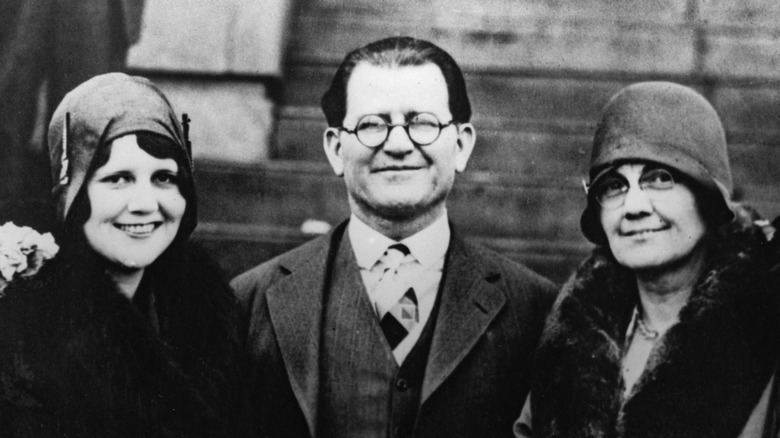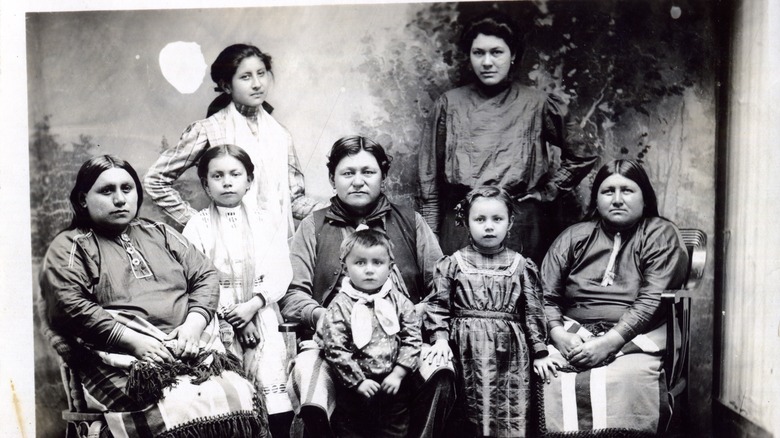Ree Drummond And Killers Of The Flower Moon: Is The Connection Real?
Ree Drummond isn't probably a name you would expect to come up in relation to a historical crime drama by Martin Scorsese. However, the Pioneer Woman appears to have a historical connection to the film "Killers of the Flower Moon" and the real-life tragedy that took place in Osage County. It turns out that Drummond and her family live on some of the land at the heart of that film's narrative.
"Killers of the Flower Moon" is based on the real-life exploitation of the Osage tribe in the early 1920s, in which white settlers and ranchers tried to swindle them out of land rights. It all boiled to a head during a period dubbed historically as the Reign of Terror. Around two dozen Osage tribe members were murdered as part of the scheme. Bloomberg reporter Rachel Adams-Heard reported about the Drummonds' connection to Osage County during this historical time period on her podcast "In Trust." Speaking with Slate, Adams-Heard explained, "When you add up all of the land that the extended members of the Drummond family own today — or as of last year, when we did our analysis — it is nearly 9% of the entire county."
That land is broken up among several of the Drummond kin and is worth roughly $275 million. The Pioneer Woman, who married into the Drummond family, reportedly lives on one of the larger ranches. And while the Drummonds aren't the subject of the film, they do play into its historical significance.
The Drummonds' connection to Osage County
Prior to the Osage Allotment Act of 1906, the 1.5 million acres that make up Osage County belonged to the Osage Indian Reservation. The act broke this land into individual lots that could be sold off or farmed by the Osage people. Around this time, the government established something called a headright, which would make the tribe the target of ruthless and savvy white settlers. Headrights were communal shares, separate from land, that entitled the owner to profits as a result of the booming gas industry that would come to Osage. Because headrights couldn't be sold, only inherited, some settlers resorted to underhanded tactics to acquire headrights from the Osage tribe.
One legal method, which Vanity Fair claims the Drummonds engaged in, was becoming the legal guardians for Osage tribe members. This would place white settlers over the finances of Osage members whom a court ruled incompetent. As such, it led to both racism and corruption in the community. Bloomberg's "In Trust" podcast reports that the "three Drummond brothers were guardians to at least 10 Osages — children and adults."
William K. Hale, the subject of "Killers of the Flower Moon," even resorted to murder. The Drummonds ended up purchasing Hale's land after he went to prison. As Bloomberg reporter Rachel Adams-Heard told Slate, "When he was arrested, he sold his land to a partnership between the Drummond family and another prominent Oklahoma ranching family, the Mullendore family."
Where do things stand now?
In the present day, the Drummond family still owns three-quarters of a headright. But according to The Oklahoman, they're planning on finding a way to return the headright to the Osage people.
Ree Drummond married Ladd Drummond in 1996 and currently lives in Pawhuska, Oklahoma on the ranch that she made the base for her media empire and food line. Drummond's historical connection to these real-life murders is getting a spotlight, thanks to the film, but it was surprising to most. In a now-viral tweet, Noa Bourne first brought it to the attention of many, writing, "My mom just said her 'Roman empire' is how the pioneer woman's family owns all the land killers of the flower moon is about."
Since then, others have shared their thoughts about the connection. On Reddit, one person wrote, "Oh yes I've been waiting for this to become known. That family is so wealthy and powerful y'all have no idea." Another commented, "I remember this being news years ago and her fanbase was shocked (I think people felt misled by her branding?), but then it was just...forgotten." It is the hopes of the current-day Osage people to reclaim some of this land, with some members of the Osage Nation looking to establish negotiations with the Drummonds.


